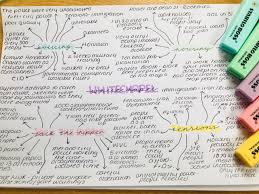Ultradian rhythms
Cards (20)
- How long is an ultradian rythm?shorter than a day
- What’s an EMGProvides info about muscle tension or relaxation
- What’s an EOGShows electrical activity that occurs when the eyes move REM
- Describe the research carried out by Loomis et Al
- Used EEG to record electrical activity in sleeping persons brain
- Discovered brain is electrically active during sleep
- Waves got “bigger” as sleep got “deeper”
- Two positives of research into the nature of sleep?
- ☺️ Universality of sleep- stages 3 and 4 occur only in the first two cycles and REM sleep always increases in duration with each successive cycle (can be generalised to all people)
- ☺️EEGs, EOGs, and EMGs provide evidence- these methods produce objective measures and are less subject to bias- reliable and valid
- Two disadvantages of research into the nature of sleep?
- ☹️ sleep lab is artificial- pps wired up to machines which affect the natural nature of sleep, can reduce the length of time asleep as pps are influenced by machines, reduces ecological validity and mundane realism, however high control
- ☹️ Individual differences- Tucker et al- 11 pps, length of sleep, time to fall asleep and time spent in each sleep stage assessed. greater variation in sleep patterns with people who sleep for different amounts of time. Longer sleepers spend longer in REM sleep- beta bias in minimising differences between sleepers
- How many times do stages 3 and four occur during sleepDuring the first two cycles of sleep only
- In how many cycles does REM sleep occur?
- During every cycle of sleep
- Episodes increase in length throughout the night
- In what order do we enter sleep and go through the first cycle of sleep?
- Awake and alert
- Relaxing
- (beginning of sleep) stage 1
- Stage 2
- Stage 3
- Stage 4
- REM sleep
- End of REM sleep marks the end of the first ultradian sleep cycle
- What is an ultradian rythm or cycle?Cycles that last less than 24 hrs
- give a general outline of the five sleep cycles in the basic rest activity cycledaily cycles of wakefulness follow circadian rhythm, (sleep wake cycle) within the sleep portion of this cycle another ultradian cycle exists- (basic rest activity cycle- BRAC)
- FIRST SLEEP CYCLE- stages 1, 2, 3, 4. Stage 4 = 40 mins, then go backwards to stage 3, 10 mins in stage 2 and skip stage 1 to first episode of REM
- SECOND- REM ends, enter stage 2, then 3, then 4, then REM for ten mins
- THIRD- enter stage 2, then REM for 40 mins
- FOURTH- stage 2, REM 60 mins
- FIFTH- wake up during stage 2/REM
- how long does each sleep cycle last for?approximately 90 mins
- what did Kleitman suggest about the BRAC?
- this 90 min ultradian rhythm occurs even during the day
- move progressively from a state of alertness into physiological fatigue approximately every 90 mins
- towards the end of the 90 mins, the body begins running out of resources, resulting in loss of concentration, fatigue and hunger
- evidence- 10:30 am morning break splits the 9 am morning - noon session into two 90 min portions
- true or false? sleep is described as a single stateFALSE- sleep is described as several shorter rhythms within it- not a single state
- what three devices can be used to detect activity during sleep?
- EMG- info about muscle tension/relaxation
- EEG- info about electrical activity in the brain
- EOG- info about electrical activity when the eyes move (REM sleep)
- what is NREM sleep?
- non-random eye movement sleep
- occurs during stages 1-4 of the BRAC
- characterised by dreamlike experiences but a lack of vivid visual images (research by Dement and Kleitman- derived from waking people up during NREM sleep)
- what is a hypnagogic state?characterises the transition from relaxation to stage one of sleep- experience dreamlike/hallucinatory images
- describe what is meant by REM sleepoccurs in all mammals, rapid eye movement sleep, experienced when someone is dreaming. Body enters state of visual paralysis- deep sleep in which one would find it difficult to wake up
- what internal processes happen as we enter sleep?
- breathing and heart rate slows
- body temp drops
- muscles relax
- onset of sleep is marked by irregular and slower theta waves
- heart/breathing rate and body temp at lowest at the deepest stages of sleep (stage 4)
- electrical activity increases in amplitude and becomes slower (eg- slower delta waves) as sleep becomes deeper (eg around stage 3)
- what is the main ultradian rhythm in the body?sleep cycle (basic rest activity cycle)
